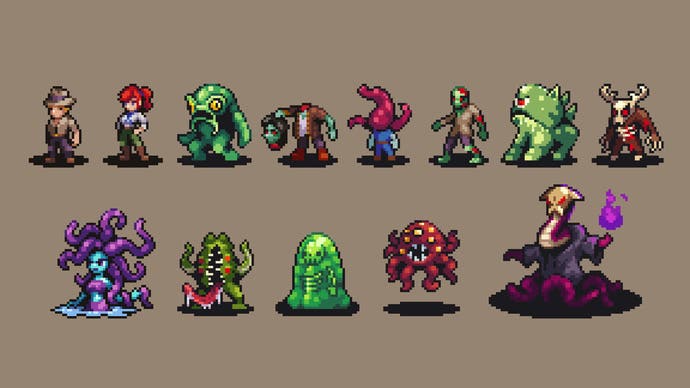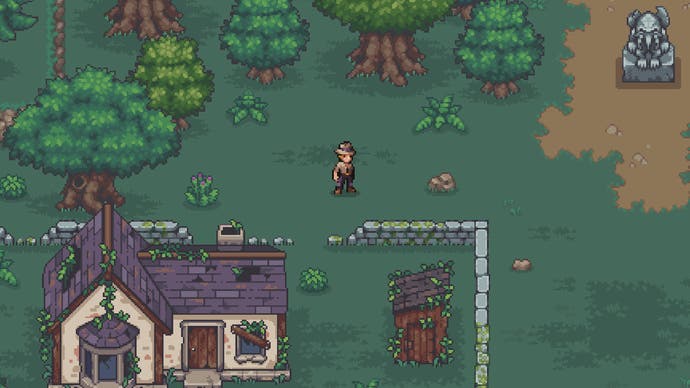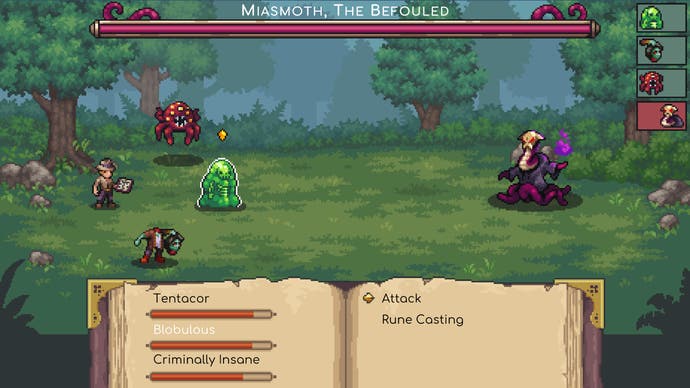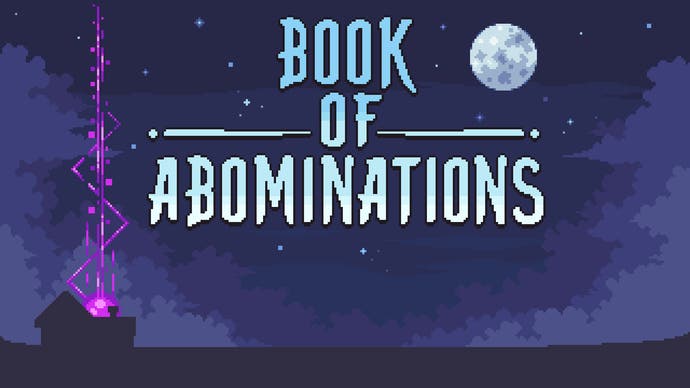Uncovering the eldritch horror monster-collecting RPG Book of Abominations
"Charming and charismatic meets unsettling and grotesque."
I was so taken with one game at EGX 2023 that I returned to play it every day I was there. It's called Book of Abominations and it's a bit like Pokémon - if Pokémon existed in a Lovecraftian nightmare.
Essentially, Book of Abominations is a monster-collecting RPG where you accidentally release monsters into the universe after finding a big, suspiciously evil book. And because it was your fault, it's now your job to find all of these monsters and return them. Most of them are semi-willing to go back inside but some big ones you will need to fight first. Luckily, though, as you capture more monsters, you'll be able to build bigger and better teams to deal with them.
Combat is turn-based and you can get your allied monsters to chip away at the enemy's health until, once you’re confident you can win, you can perform the Capture Ritual to return the monster home. It sounds simple but I couldn't stop going back to play it. Perhaps I was under the influence of a Capturing Ritual myself.
I was fortunate enough to have the chance to talk to the game's maker, Magination Games, after the event to learn more about their early development title. Alex de la Cour is the team leader, artist and one of the programmers. Jan Huss is also one of the programmers, a producer and audio designer. They both wear a lot of hats, as they say. Both created the game as part of the DARE Academy competition hosted by Abertay University and subsequently, they won every category.
Eurogamer: The horror-Pokémon concept seems to have really captured people's Imaginations. Where did it come from?
Alex de la Cour: Book of Abominations is an eldritch horror-themed monster-collecting RPG. In a nutshell, it's Pokémon meets Lovecraftian horror with elements of JRPG turn-based combat thrown in.
I came up with the idea quite a while ago. While learning pixel art I used to post a lot on this Twitter account, Pixel Dailies, where they put out a daily theme and people post their interpretation. I can't remember the exact theme - I think it was Pokémon - and despite making a game like this I've never actually played Pokémon, but I knew what the concept was. I made this little gif of Cthulhu being sucked into a necronomicon style book of the dead and posted that this was my take on capturing monsters.
Everyone commented things like: "You should make that game!" "Sounds like such a cool game idea!" Then I was like, you know what? I should make it.
That was a few years ago. I didn't have any of the skills whatsoever to make the game I wanted to at that point but I kept the idea tucked away, kept levelling up the skills. Then I met this dude [they gesture to Huss] who is really cool and good at everything that he does. I told him about it, he was like, "Yep, let's do it," and here we are.
Was the pixel art style one of the first things you decided on?
Alex de la Cour: Kind of alongside it. Pixel art is the only artistic medium that I know at all. I can't do 3D art or anything like that, so pixel art has always been the only thing I know as far as making games goes, and I don't think that will ever change. I love it far too much.
It was absolutely charming when I played it - the art style was lovely. I still have the stickers.
Jan Huss: Yes!
Alex de la Cour: Awesome. Charming is what we're going for - charming and charismatic meets unsettling and grotesque. That's [the thinking behind] everything we design for the game and we tried to fit it into that, so I'm glad charming came through.
Book of Abominations grew out of the DARE Academy. Can you explain a bit about what that is?
Jan Huss: We didn't know what DARE Academy was until two years ago. It's a competition - well, you call it a competition but it's something else - that Abertay University hosts once a year. You get to apply as an undergrad student with a team of two-to-eight people. You pitch a game - it could be a project that you've already been working on, could be something that doesn't even exist, like a scribble on a napkin - then you go through an application phase and an interview stage. Once you get in, you do a hot-housing month with industry professionals. You work on the game all summer until you go down to EGX to showcase it.
It's an incredible opportunity that Abertay provides. It gives you the chance to network, to hone your skills and to look at things that you might have missed in game development. Because we're only a team of two, we had to pick up so many different roles that we never experienced before and just learn on the fly. But I'd like to think that we did well.
Alex de la Cour: We won every award on offer so I think we did okay!
Fun Fact - Jan didn't realise he had the crown on until much later that day.
In terms of monsters, is there a general amount that you want players to be able to catch eventually?
Alex de la Cour: Oh, that's that's a point of debate between the two of us at the moment.
Jan Huss: Yeah.
I don't want to cause any trouble!
Alex de la Cour: No, no, we don’t need you to cause trouble - we do that plenty naturally!
It's trying to find that sweet spot between wanting to put all the monsters that we can possibly come up with in there, and also trying to be realistic with: we have X amount of time that we want to be working on this game and we have X amount of things that we need to do in that time. How much of that can we dedicate to designing and animating monsters, all their different forms and phases?
Animating monsters is probably the most time consuming part of the artistic process for me. It’s my favourite part. It's also something that I need to rein myself in. As far as how many, it could be fifty, it could be one-hundred. I'd say probably somewhere within that range at the moment, but that number could wildly change between now and when we release the game.
Eurogamer: Are we going to be able to catch multiples of the same species of monster?
Jan Huss: The idea is that you will only be able to capture a monster once per game. But that doesn't mean that you can’t still perform capturing rituals on the same monsters you might already possess.
The idea is that the monsters you own in the book will be placed in your bestiary and these monsters will become stronger the more often you capture a duplicate. So it's a little bit of a different spin. The way we thought of doing this is that we would give them proper heavy boosts to make the monsters in your bestiary stronger rather than having a whole team of the same monster.
Alex de la Cour: I feel that you get one and you have a little bit of a connection to that one type of monster, and it makes it a bit more special having that one type in your party. If you have twenty of them, it loses a little bit of that connection.
I did feel a connection with the slimy green one at EGX.
Jan Huss: That's my favourite. [Alex de la Cour's favourite is the monster with several tentacles and eyes.]

Can you battle the monsters against each other with inter-team fights amongst your own? Or do they make up a team to battle a specific set enemy?
Alex de la Cour: That's something we have not considered.
The way things are going at the moment, you'll have a lot of control of your own monsters and try to get the best team in place for the fight that you have at the moment. But as things stand, it will probably mostly be fighting against the bosses and the monsters that the world throws at you rather than your own. But maybe that's something to look into, like some sort of practice or tutorial system of fighting your own monsters against each other. We like giving ourselves extra workload!
Jan Huss: That's the way to put it!
The audio seems to bring a lot to the atmosphere. Was this a deliberate focus before you went in, or did it emerge organically?
Jan Huss: We were looking at previous monster-collecting games and there's always been a digital aspect. For example, in the older Pokémon games, that's all they had. They couldn't use actual sounds and I wanted to stay with that as well, a little bit. I wanted to give a sense of realism from certain samples in terms of sound design, but I did want to maintain this digital aspect in a world that’s set in a similar theme towards the late 1800s.
I felt like, why not go modern with something that could look from an older timeline? In terms of the sound while walking, the music while playing, soundscapes, and music: I felt like a rocky vibe fits eldritch horror quite well. I combined chiptune and the digital aspect of music with a little bit of a rocky flair to combine it to make it feel right. I hope I did the music justice!
Alex de la Cour: I can say this because I didn't do any of it, so it's not like I'm being really big headed and talking about my contribution, but the music in the game is amazing.
Jan Huss: Thank you.
You've both mentioned eldritch horror a few times. Is that an important influence for you - is that your favourite genre?
Alex de la Cour: I've played a little bit but I wouldn't say it's anywhere near my favourite genre. I play quite a lot of Bloodborne, which is pretty much it. I probably would be more interested in movies, some books and stories that touch on those themes rather than the actual games themselves.
Jan Huss: I play a lot of games that are more modern - Cyberpunk or anything related to that. But we both play Dungeons & Dragons. We do have certain eldritch themes pop up every now and again. There's a whole system [for] Dungeons & Dragons meets eldritch horror, and it's completely different. It's very eldritch inspired and maybe that's the closest that we're both with eldritch [games] right now.
Alex de la Cour: I guess this permeated through a lot of the horror that comes out at the moment. It's fun to create that almost gloomy, dark atmosphere and it's really fun to design monsters that look like that. You don't have to follow any rules of what's realistic or less biologically possible, you've just got to give it as many creepy, weird, out-there features as you can. And the more the merrier.
Jan Huss: I think as well, it's actually quite a fun aspect to create our own eldritch horror-themed lore. We’re not sticking to anything that’s already canon in a different universe, and that’s actually quite a big, fun aspect. Because we're both not too deep into the eldritch horror theme, it gives us a completely different way of being creative
Do you find that the storytelling evolves as you create the monsters? Or is it completely separate and you weave the monsters into it?
Alex de la Cour: I think it's quite separate. We've gotten a lot of the narrative in the story set out, but it's not quite nailed down in canon. It's more that we have an idea for the game, the mechanics and how we want the game to be. We don't want the story to get in the way of that too much at the beginning, and push us in a direction that might make the game less fun to play. We weave the story into that, but it's very much still a work in progress.

Is it going to be an area by area place to explore, or is it going to be an open world?
Alex de la Cour: I would imagine it will probably be maybe somewhere in between the two. You have your central area that branches off into a few other places. Maybe some of them are a little bit interconnected, but the different branches are probably going to be mostly linear-ish. Yeah, I'd say somewhere between the two.
It sounds like a good blend of modern and retro.
Alex de la Cour: That's a lot of what we're going for, a blend of the familiar with the new.
Were there any particular retro game influences or was it more of a natural thing that it has that vibe?
Alex de la Cour: For me, there's a lot of pixel art game influences. I'm a bit older so I grew up with Super Nintendo and Sega Mega Drive generation of games. A lot of my influences personally are Eastward on a level - I really love that game - some of the Final Fantasy games largely, like Final Fantasy VI, but also some of the sort of middle era Final Fantasy games like VII, IX and X - especially on the turn-based combat that we're down for.
Jan Huss: Personally, there's a game called Golden Sun that used to be available on Game Boy Advance. A lot of ideas or inspiration [for me] comes from that game/series. So, all pixel art relaxed.
Alex de la Cour: You played some of the older Pokémon games right?
Jan Huss: Yeah, and Pokémon was a huge factor as well, and that was my first game on the Gameboy pocket, Pokémon Red.
How did you land on turn-based combat?
Alex de la Cour: A fair bit of trial and error, a lot of meetings, looking at some other games, seeing how they do it, and seeing how we could adapt that - seeing how it would work for what we were trying to do. I'm a big Final Fantasy fan, so that felt like a natural jumping off point for me. How does one of the best turn-based combat games do it? Where do we go from there?
There were some other games where we looked at how they do it. Obviously Pokémon's a big one, but Darkest Dungeon as well - that was a very early possibility, to do something similar to that.
Also - and this is not a good reason to decide how combat mechanics should work - I wanted you to really be able to see the monsters clearly because I designed them with so much love. So it was like, 'Okay, if we put them in this position on the screen, then you can see them all really clearly. And they stand out.'
A big part of the next move now is, now [that] we've got the proof of concept for turn-based combat, how can we make that more interesting and more engaging? That's going to be a very big part of the next stage [of development].

Speaking of development, what has been the most difficult part of the early process for you?
Jan Huss: I think a difficult part might have been fusing the combat system with the capturing system. That was one of the biggest challenges.
Are you OK if I use that? [de la Cour agrees]
Originally, you could just capture a monster when you start a battle. There was no incentive to battle them, which was a huge core mechanic. It was trying to get it right, to incorporate the mechanics of performing rituals to capture the monster and to battle them at the same time.
We want it to be a strategic experience. We don't want to just have this whole experience of just battling or capturing. You actually do have to capture monsters to make yours stronger, we needed to find the right balance for that, it took quite some time.
Alex de la Cour: Someone played it and said it felt like we had two separate combat systems - that they weren't really merging. That was a real like okay, how do we make that not the case? How do we make it cohesive and feel like you need to do a little bit of both? That was tough.
Jan Huss: We got there!
Alex de la Cour: Yeah, and the game got tremendously improved for it.
Did you find that feedback like that was a massive factor in how it has turned out so far?
Alex de la Cour: Definitely. Someone told us quite early on in the development that when people give you feedback, the solution that they suggest - more often than not - is going to not be the solution for us. But the problem is usually an actual problem that we need to address, and that was one of the best bits of advice I've [had] for game development.
We did it as DARE Academy - we've had industry people who have years and decades of experience playing it and giving feedback. It was invaluable for it to be what it is.
What has been your favourite part of making your game so far?
[Audible silence.]
Oh dear. I feel like I've thrown a spanner in the works.
[They laugh.]
Alex de la Cour: The part of development I get the most enjoyment from is designing and animating the monsters. I could do that all day, every day. Going to EGX and getting to talk to people about the game, getting to meet awesome people like yourself and just being able to work full-time on this.
It really felt like this is everything that I've been working towards for the last few years and gave me that taste of the life that I want to live. It’s been incredible. Saying it's been life changing would be not at all hyperbolic. It's been so cool.
Jan Huss: For myself, probably the equivalent of what Alex just said. In terms of sound, and making the sound for a game, it's so different from making compositional pieces. It's really been an amazing experience. Not just working as a sound designer, but also being able to pick up on certain things that work and don't work. That was fantastic. Again, meeting amazing people too. EGX was fantastic and we got to meet so many good people through the competition itself.
Alex de la Cour: We met people we're going to be friends with for years to come from the other teams and mentors.
Getting good feedback on the game, too - hearing it from the public. We were at Scottish Games Week and it still feels strange when someone says, "Oh, my friend told me your game's really great. I need to check it out." Then they play it, waxing lyrical about how good it is. It still feels really awesome. People liked our game? Wow!
I hope I hear that a lot more, but I also hope that I never get used to hearing it, because it really warms your heart.
I came back every day to play it, so you're definitely on to something.
Jan Huss: Aw, that’s really good to hear - thank you!
Alex de la Cour: Thank you. That was such a crazy thing at EGX. Seeing people coming back to play this every single day. There was a dude who played it for four days in a row and they’re like "I'll be back again tomorrow." I thought they were joking - then they came back the next day!
Jan Huss: There was another person who went 'game over'. They were so close to defeating the boss and said, "This was absolutely amazing. What an amazing experience." Then a day later, they came back with their friends and sat down instantaneously. Their two friends said they had told them they needed to go back and defeat this game.
It's in very early development but how long, roughly, do you think it will be until we see an end product?
Alex de la Cour: We're aiming for three years. There's obviously variables that need to be taken into account but that's the plan and roadmap that we're setting out for - about three years.
Where do you envision Book of Abominations going and what are you most excited about?
[Audible Silence again.]
There goes another spanner!
[They laugh again.]
Alex de la Cour: We're trying to stay grounded, right? Take it one step at a time, I feel like we're creating a little world that the sky's the limit for really. Whether it's just the beginning and it leads onto something else, or whether we release it and never make a game again!
It's hard to answer that question without sounding really arrogant and super full of ourselves when we haven't even completed the game yet. I feel like there's no end to the possibilities of where we could go with this - we both really love it and the world that we're creating, and will happily work on nothing else.
Jan Huss: Pretty much what Alex just said, the sky's the limit right now for us. Before, we’d just started so we want to keep on working on the game. We've just taken a week's break right now just to catch up with uni work, decompress. But we really can't wait to keep on going. It's going to be very exciting.









